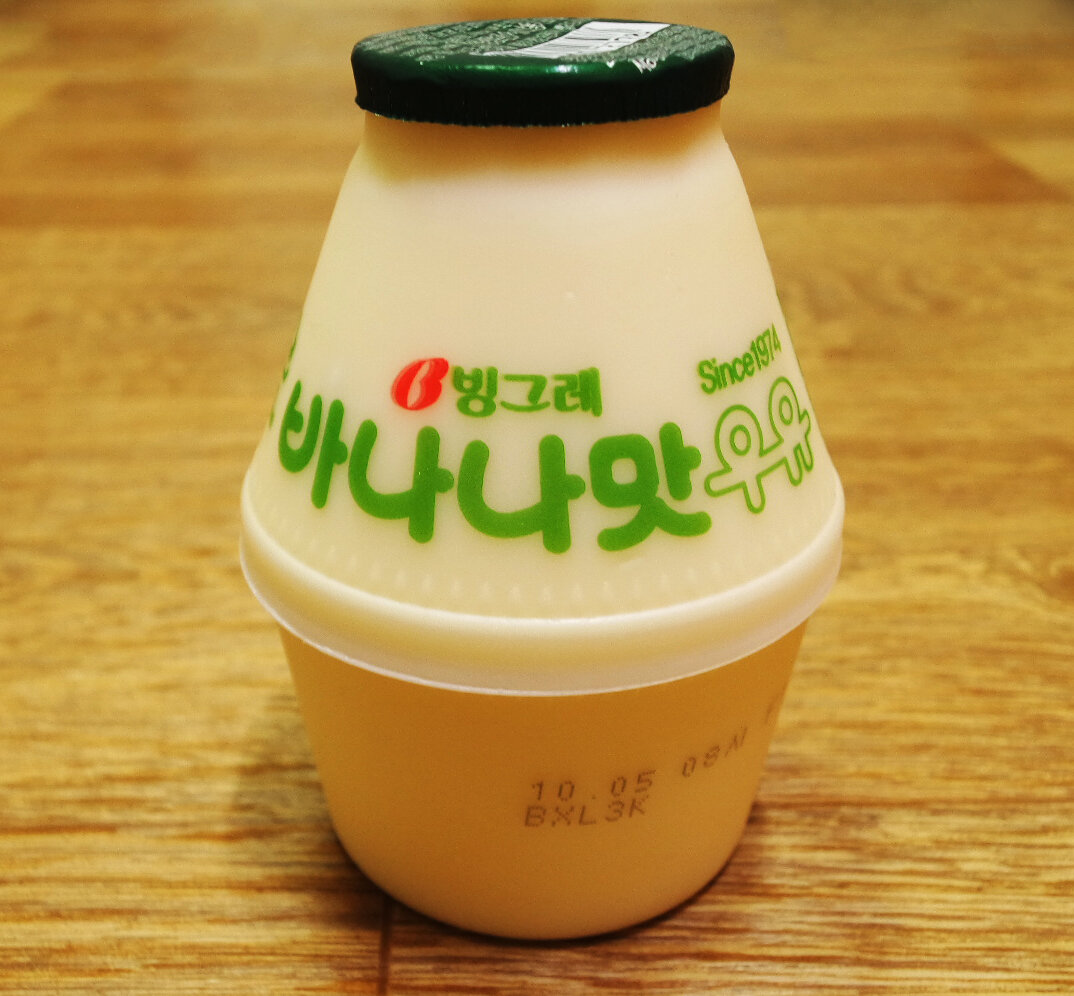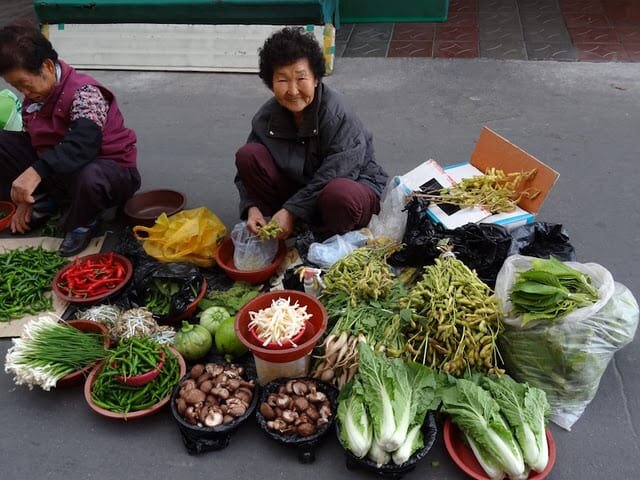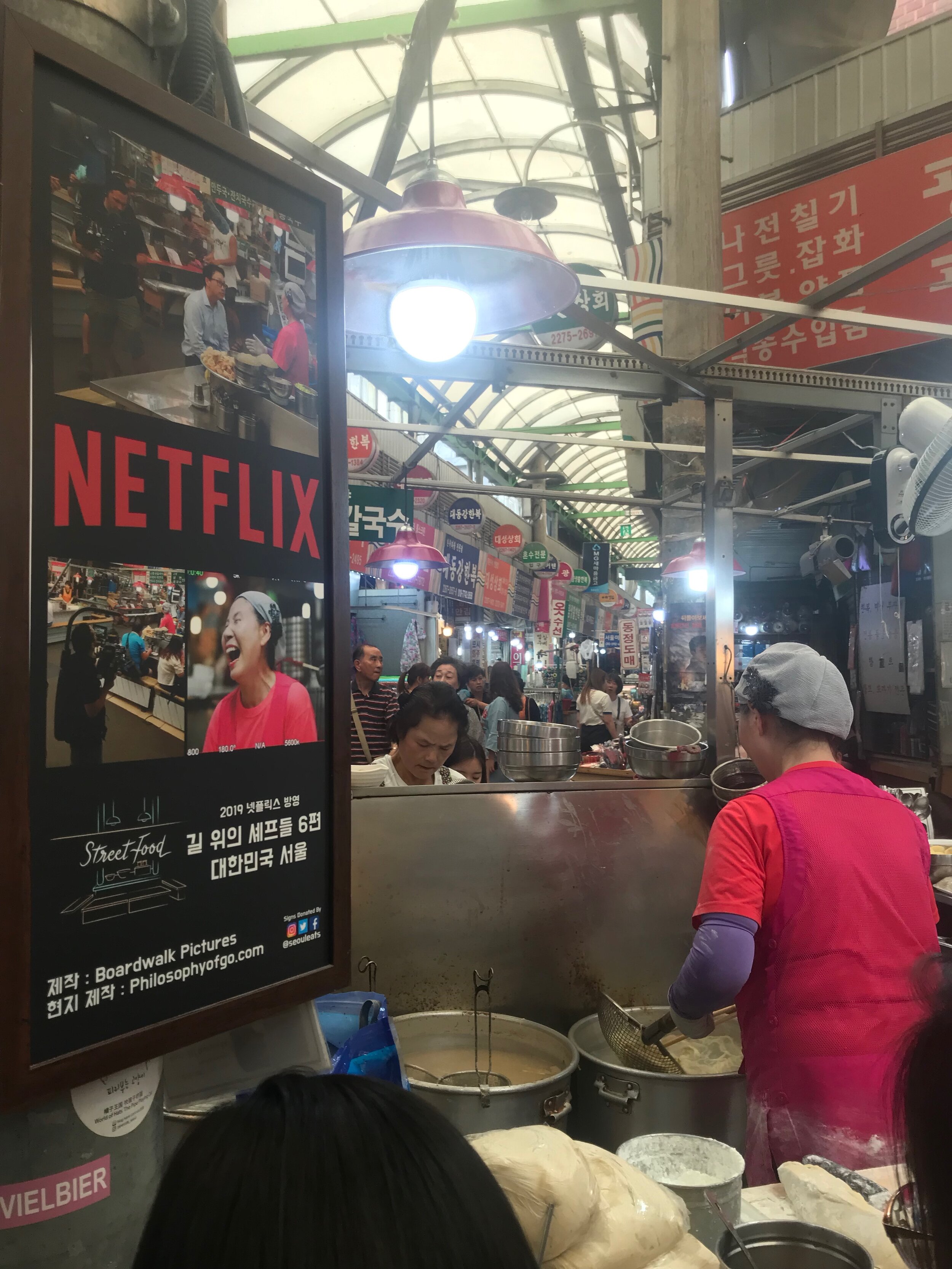A Guide to Eating Well in Korea (As If It Were Hard)
If there’s one concern I hear from my family most, it’s how well I’m able to eat here in Korea.
I have to admit–I was worried before I came, too. I knew so little about Korean food culture. I thought, what if I get tired of Korean food? Will I be able to make my favorite staples? And what will I do about Thanksgiving?
Well, after 2 years here, I can speak to those concerns now. So, if you’re moving to Korea, hoping to, or just curious about how I grocery shop abroad and get all my pasta, read on. This article is mostly geared towards Westerners who aren’t familiar with Korean food or food culture.
Also, I gotta say upfront—it’s really not hard to eat well here. Korean food is amazing and western food is way more accessible than it used to be. Come with some cultural sensitivity under your belt. I know foreigners who think fish in soup is gross, or who refuse to learn to use chopsticks. Don’t be that person. Be respectful of the culture you’re choosing to move to. Try Korean food before you get there. And don’t expect Kraft Mac n Cheese lol.
NAVIGATION
To Eat out or stay in?
In general, eating out in Korea is really inexpensive compared to what you’re probably used to. Western restaurants serving, say, brunch, will be more expensive, of course, but it’s still usually cheaper to eat out than in. A great way to look for places to eat is to use the app Mangoplate or to search Naver (both might require being able to read Hangul).
Ordering take-out is ridiculously easy. The major food ordering app is Yogiyo (요기요), and selection depends on where you live. You can pay with card or cash.
Yogiyo, the most common app for ordering food
Another thing to keep in mind is that Korea’s food culture is centered around family-style eating. Sharing food is common. You usually go somewhere and order for the table. Because of this, many places might not serve you if you’re a party of one.
I personally don’t order much take-out because my area mostly has family-sized portions, and I don’t feel like paying family-sized prices. Due to rising food price inflation, you have to be smart what and where you buy in order to really see cost effectiveness.
So, let’s talk about grocery shopping by starting with the chain stores:
Major Grocery Chains
There’s a couple of major grocery chains all over Korea: E-mart, Homeplus, No Brand, and even Costco in some major cities. They’ll each offer different selections in different cities, especially when it comes to international foods.
For example, my E-Mart carries all your staples, plus some international foods like pasta noodles and sauce, jarred pesto, Sriracha, Thai curry paste, tortillas and more. Usually has a food court. No Brand is their “generic” brand that usually runs cheap. They also have brick and mortar No Brand stores.
E-Mart Traders, which is a wholesale version of the former, and is said to have more options, but I’m not that impressed with it.
The closest Homeplus also will have most staples. Their international aisle (at least in Daejeon) has a few jars of jam and some canned soups and beans.
As for Costco, I only go for specific items I can’t get anywhere else, like pumpkin pie for Thanksgiving, as I a) don’t have a membership and b) it’s really far from me. But I hear their pizza is amazing.
Honestly, that’s the most important bit: where you’ll shop will usually depend on what’s closest. Most expats here don’t have cars, so that means you will have to walk or bus to and from the grocery store, which will limit how much you can buy. The best way to get around that is to order in bulk online, but I’ll get to that.
A quick aside for our savior, Daiso
You can totally buy household goods like toilet paper or dish soap at these bigger marts (keep an eye out for 1+1 sales!), but I recommend going to Daiso for all of that. Daiso is a Japanese dollar-store brand that is all over Korea, and they are cheap. Seriously, I stocked my entire apartment using Daiso for, like, a dollar per item.
But Daiso doesn’t sell produce, so when it comes to routine meal prep, you should head to your nearest E-mart or Homeplus. Produce in Korea is more expensive than in most countries, since it’s grown domestically, rarely imported, and producers can set their prices higher. It’s also much more dependent on seasonal changes–oranges and sweet potatoes in fall, strawberries in winter, etc.
It’s better go to these stores in the evenings, because they’ll start providing discounts on whatever fresh produce hasn’t been sold yet.
You’ll be able to find most staples you’re used to: potatoes, onions, broccoli, for example, are all available at pretty much any grocery store, even the tinier marts. Some things will will be a little different, like Korean pears or starchier sweet potatoes. Other things won’t be easy to find–I rarely find cilantro, and if I do, it’s sad, wilt-y and expensive.
Also, good cheese is (used to be?) difficult to find. It’s easier now than it was even a year or two ago. Costco has more options than E-mart or Homeplus, like Camembert and Parmigiano-Reggiano, but be ready to spend a pretty penny on it.
Things are changing all the time though. In the past year alone, I’ve seen E-mart start selling more herbs like basil and parsley, and more options for cheese like fresh mozzarella and kraft slices.
Local Grocery Marts & Convenience Stores
There will be tiny neighborhood grocery marts nearby no matter how big or small your town is. These are great for making little runs to grab milk or what-have-you. That said, these will be very unlikely to carry a range of international foods. At best maybe pasta noodles or peanut butter. Because these are smaller, often independently-owned stores, the prices can sometimes be higher than bigger chains—but you also might find better deals on what’s in season. It depends, but they’re always good when you’re in a pinch.
Big chain supermarkets close every other Sunday to give these local marts a chance.
Convenience stores can also be used in this way–they will almost always carry milk, coffee, and ramen. The biggest brands are GS25, E-Mart 24, Ministop, CU, and, of course, 7/11. You should also try sausage-on-a-stick, kimbap, and banana milk. That’s the true Korean food experience.
Online Shopping
Online shopping is, in my experience, the best and most cost-effective way to buy bulk items or international foods. The three major online stores are: Gmarket, Coupang, and Iherb.
Gmarket is almost like ebay, and you can get cheap clothes, shoes, household items, and food off there.
Coupang, however, is my favorite. Coupang is better for food stuffs in my opinion, and this is where I buy bulk bags of rice, coffee beans, tea, water filters, and any international food I’m wanting. You can also buy fresh items like produce or dairy with the Rocket Fresh program, but I normally don’t like to after that time I tried ordering sour cream and it showed up like 4 days late and very soured. My fault for trying to buy dairy online, I guess.
Iherb is best for medicine, vitamins, herbal remedies, teas, that sort of thing. Shipping is very fast.
Payment for all of these can be a bit of a headache to set up, but if you have a Korean bank card, you should be able to sign up or use an ATM to transfer the money. Most people use a translator app or ask their coteachers for help with it.
You might also be able to order monthly meal plans or food deliveries, a la Hellofresh, from marts around Korea, like Mogoeat or Sprout Natural Healthy Whole Food Service. I can’t vouch for any of that personally, but it’s worth checking out.
Traditional Markets
Korea has a billion traditional markets, and there’s SO MUCH you can eat and buy. The biggest ones in Seoul are Namdaemun and Gwangjang markets (the latter is featured in Netflix’s Street Food). My favorite thing is to go and sample bindaetteok (빈대떡), hotteok, (호떡 ), tteokbokki (떡볶이) or some fresh coffee.
But little sidewalk markets pop up all over. You’ll see them on the sides of the street, in the back of a truck, or even down in subways. You can usually grab a bag of fresh produce for super cheap, but keep in mind it’ll be cash only.
International Food Stores
If you’re lucky (or unlucky, depends on how you feel) enough to live in Seoul, it’s so much easier to find international food stores. Itaewon, which is considered the foreigner neighborhood, has tons of restaurants and stores that carry ingredients you might not find anywhere else, like spices.
Here’s a list of halal food marts you can find!
However, because I don’t live in Seoul and don’t find myself in Itaewon often, I really don’t shop here ever. Your access to these foreigner marts will heavily depend on where you live. Even in Daejeon, which is a big city, there’s few—one in Gung-dong and another near Daejeon Station.
Adapting to the Korean Diet
Coming from Texas, I ate a distinctly American diet while growing up. My family also didn’t eat a ton of veggies when I was young–we were very “meat and potatoes.” Throughout college, I started experimenting with more foods, eventually resulting in these really elaborate meals. But moving to Korea required me to go back to basics–spaghetti, quick fried rice, eggs on toast.
While I’m able to find some international foods, it’s generally just cheaper and easier to adapt to a more Korean diet while I’m here. I eat a lot more rice, tofu, mandu, etc. than I did back home.
If you’re wanting ideas for how to cook with Korean ingredients, I recommend Maangchi or Future Neighbor for finding simple and quick recipes. They’re both a delight and they also break down Korean brands and ingredients, like how to pick the right soy sauce. Don’t be like me, don’t buy soup soy sauce when you want regular because you can’t read.
I make Future Neighbor’s breakfast rice bowl all the time!
Going Veggie
Another big shift is I also rarely eat meat at home, as beef prices are higher here, and low-fat alternatives like turkey are hard to find. Chicken is available, but still more expensive than what I’m used to.
I’m not a full vegetarian yet because, while I’ve got quite a few friends who do it, being vegetarian in Korea actually isn’t easy. Many places will use chicken, seafood, or beef broth without disclosure, as that’s not seen as “meat.” Here are two resources for eating vegetarian or vegan in Korea: one and two.
Bibimbap (mixed rice) which can often be made vegetarian
Oat milk, soy milk, and other dairy alternatives are becoming more popular, but I only ever find them in the little International Specialties section. Honestly, I expect these to pop up more and more, as I think it’ll be Korea’s next “food fad.” (Right now, we’re going through a boba phase. It used to be just Gongcha that sold bubble tea, but now every cafe down the street has it.)
It all depends (like usual)
The last thing I want to mention is that what you’ll be able to make will depend on your housing. Most Korean homes don’t have full-sized ovens, although you can buy toaster ovens online (and I have, it’s great!).
If you’re working with EPIK, by contract you should get a fridge, microwave, and stove top. Kitchens are typically small–I only have one stove burner, although I think I’m the outlier. Because of this, making big meals with several sides is difficult. Thanksgiving in particular is always a question of who has the biggest kitchen. A lot of it boils down to determination—while I don’t cook meals nearly as complicated or multi-faceted as I used to, people do it.
I don’t miss for much, except maybe really good cheese. Hell, I still make breakfast tacos at home just fine and that was my go-to in the US. But, like with anything about moving, it requires an adjustment.
Like I said up-top: keep an open mind. You don’t have to love spicy food or seafood to eat well here, but don’t treat those things like they’re gross or weird either. I shouldn’t have to say that, but you’d be surprised the things I’ve heard teachers say…
Anyway, thanks for reading!








